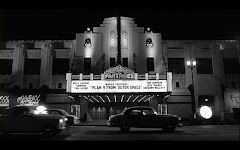 One of my very first posts (number 7 to be exact) was a brief eulogy for John Flynn, a director who specialized in crime thrillers. At the time I wondered why his much revered transcendent exploitation classic Rolling Thunder was still unreleased on DVD. We’ll over three and a half years later and after popping up in High Def on several cable stations as in addition to being well traded on the grey market, Rolling Thunder will finally make its official debut appearance on the digital platform next month via an MGM burn on request endeavor similar to the Warner Archive series.
One of my very first posts (number 7 to be exact) was a brief eulogy for John Flynn, a director who specialized in crime thrillers. At the time I wondered why his much revered transcendent exploitation classic Rolling Thunder was still unreleased on DVD. We’ll over three and a half years later and after popping up in High Def on several cable stations as in addition to being well traded on the grey market, Rolling Thunder will finally make its official debut appearance on the digital platform next month via an MGM burn on request endeavor similar to the Warner Archive series. As happy as this news is, I can’t help but feel this release is a little anticlimactic. Here is a film that has become a staple amongst a certain sect of 1970’s/1980’s genre cinephiles (for naught was it one of the first films covered by the Gentleman’s Guide to Midnite Cinema podcast), most of whom, similar to myself own either a good quality grey market bootleg or have it in their DVRs. Considering it’s rabid fan base, which includes Quentin Tarantino, this release, welcome as it is, is a bit of a disappointment. If I was operating a DVD company with the rights to Rolling Thunder (and hey, I am employable!), these are the special features I would include on the disc:
-Audio commentary with Quentin Tarantino and co-star Tommy Lee Jones (While Tarantino has never provided a commentary for one of his own films, he’s shown up on multiple commentaries for films he’s produced or is a fan of. It would be a hoot to have him and Jones, who made one of his earliest and most distinct impressions here, and has become a director in his own right, team up.)
--Conversation between Tarantino and screenwriter Paul Schrader. (As vocal in his support as Tarantino has been, screenwriter Schrader has been equally vocal in his dissent over changes made by the production company and director Flynn to his original script of Rolling Thunder. It would be interesting to see the results when these two very opinionated and very expressive personalities debate the merits or perceived lack thereof of the film)
--Making of documentary (A feature chronicling the making, release, and growth in reputation of Rolling Thunder featuring stars William Devane, James Best (aka Roscoe P. Coltrane), Jones, and Linda Haynes. As well as various members of the crew)
--Career Retrospective: John Flynn (While never considered an auteur, he’s had a solid career as a craftsman of action thrillers starring such disparate actors as James Woods, Sylvester Stallone, Robert Duvall and Steven Seagal)
--Original script: Paul Schrader’s Rolling Thunder (similar to the original Taxi Driver DVD which featured a readable version of the script, it would be a very interesting exercise to read the script that Schrader felt was misrepresented in the final product. Especially knowing that the original draft featured an appearance from Travis Bickle!)
--Original theatrical trailer (because, c’mon…)
 But that’s not all folks, the aforementioned Warner Archives are doing a solid and releasing another 1970’s Flynn directed thriller, The Outfit.
But that’s not all folks, the aforementioned Warner Archives are doing a solid and releasing another 1970’s Flynn directed thriller, The Outfit.
Based on the Parker novels penned by Donald Westlake (written under the pseudonym Richard Stark), but adapted loosely enough from the source material as to remove any sign that it’s the third book of a series, Robert Duvall stars as Macklin (the name Parker was never used in any of the adaptations) who seeks retribution for his brother’s murder by hitting the crime organization responsible in the wallet and then the gut. Flynn doesn’t attempt to mimic the most famous Parker novel cinematic adaptation, John Boorman’s Point Blank, audacious visual and editing style, instead he employs a more straightforward narrative with solemn undertones and a muted palette.
Turner Classic Movies has aired The Outfit a couple of times over the last few years (I finally caught it this year), but the print was non-anamorphic and worn. Warner Archives’s print restores its aspect ratio and is available to purchase now. Now we only need a release of the Jim Brown starring Parker adaptation, The Split, which I wrote about here.
By the way, rumor has it that Warner Archives is having a 5 movies for $50 deal this weekend, starting tomorrow, great for cinema lovers, horrible for my Quixotic Foibles goal.







.jpg)




















































